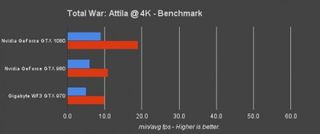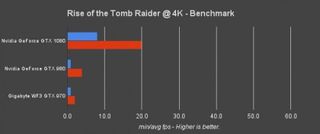Why you can trust TechRadar
The biggest conundrum the 4K Ultra HD early adopters have had was finding a suitable graphics solution to power those pretty pixels. 8,294,400 dots of resolution is no small number. And to try and render everything at 60 frames per second in some of the latest and greatest AAA titles requires some serious processing power.
In most cases the best solution was to opt for multi card setups. It's not uncommon to see dual Nvidia GTX 980 Ti's, AMD Fury X's or other bonkers solutions rigged together to bring this buxom beast to bear.

However, the problem with this lies in how both Crossfire and SLI operate. Namely, it requires support from each and every title's game developers.
Take Total War for example. Want to play Attila at 4K with an SLI profile? Too bad, they don't exist, your extra £400 card just became a paper weight. And that's why, amongst other reasons, a single card solution is so enticing.

Does the GTX 1080 deliver on that promise?
Well yeah, in our testing Far Cry Primal, The Division, and Ashes of The Singularity all performed exceptionally well at 4K, with average frame rates well into the 40s. Rise of The Tomb Raider and Total War: Attila, hammered those averages back down into the low 20s.

But it's important to keep in mind I use the maximum anti-aliasing settings wherever possible, and these games are designed to be intensive on your system's GPU. The reality is however that at 4K the pixel density within your screen is so high, you'll need less aggressive AA to counter those dreaded jaggy pixels.
What this means is in reality you'll see a lot less strain on your GPU and higher frame rates, outside of these fair, scientific and empirical testing methodologies I've utilised here.

What the GTX 1080 isn't?
This isn’t the final form of Pascal, though. This is just the GP104 GPU as opposed to the GP100 found in Nvidia’s HBM 2.0-compatible Tesla series server cards. Think of GP104 as a scaled down variant on the Maxwell series architecture.
That doesn’t make it bad, though. There’s a ton of overclocking potential buried in the GTX 1080 – the most Nvidia has ever produced. Don’t worry, we’ll dive more into this later.
The AMD fans amongst you will undoubtedly be sneering at the lack of HBM memory on this temporary flagship, and yes whilst that is true, GDDR5X is still nothing to sneer at. With a 256-bit bus, a 10,000 MHz clock and 320GB/s bandwidth it's more than capable of performing well at 4K and 1440p without any worry.

Overclocking
So, the Nvidia GTX 1080 is more powerful, has more transistors, an improved memory set, and generally kicks ass at 4K – but how far can we push it?
Well, similar to Nvidia's last generation GTX 980, the Founder's Edition GTX 1080 overclocked well. In testing we managed to get an extra 260 MHz out of the core clock, and 525 MHz on the memory clock.

This all enabled an overall boost clock up to an astonishing 2,088 MHz, which in turn bumped our 3D Mark Firestrike scores up by well over a 1000 on each resolution. Impressive to say the least. On top of that, it really didn't require that much more in the way of voltage, and remained stable and quiet throughout.
A solid win in our books.

